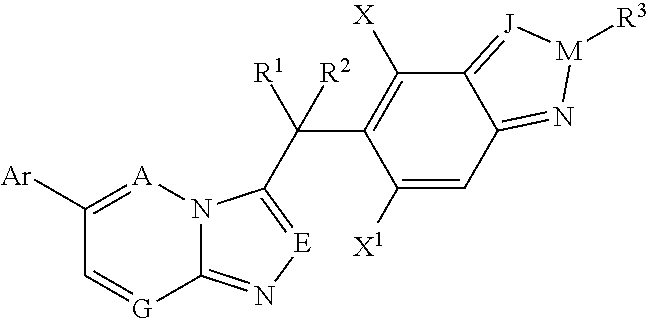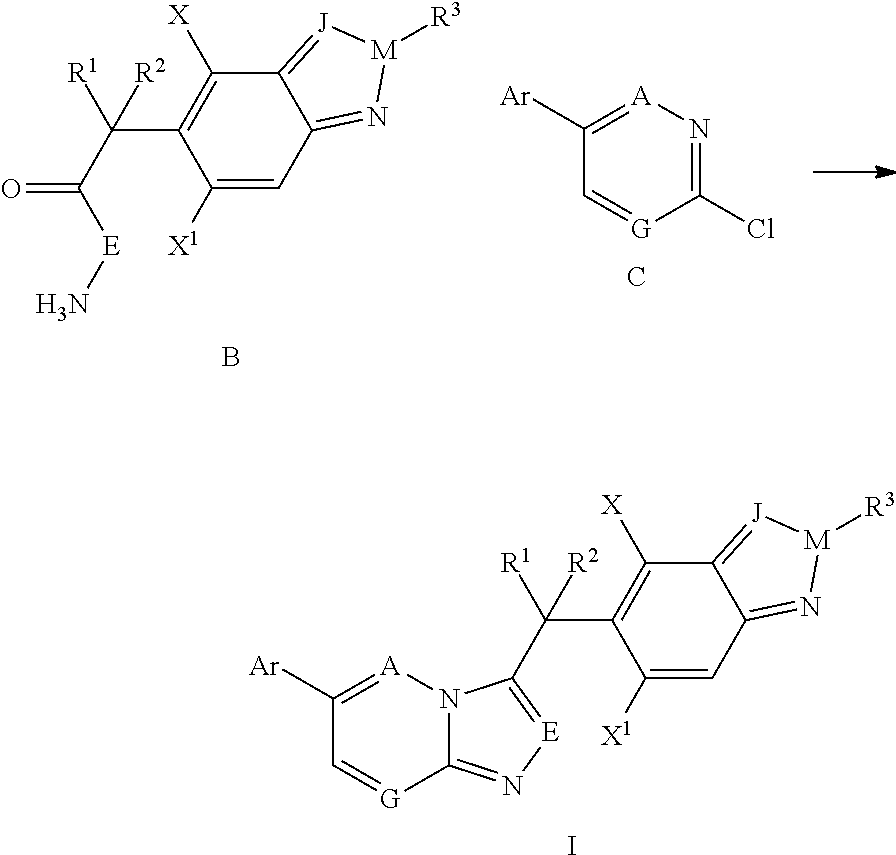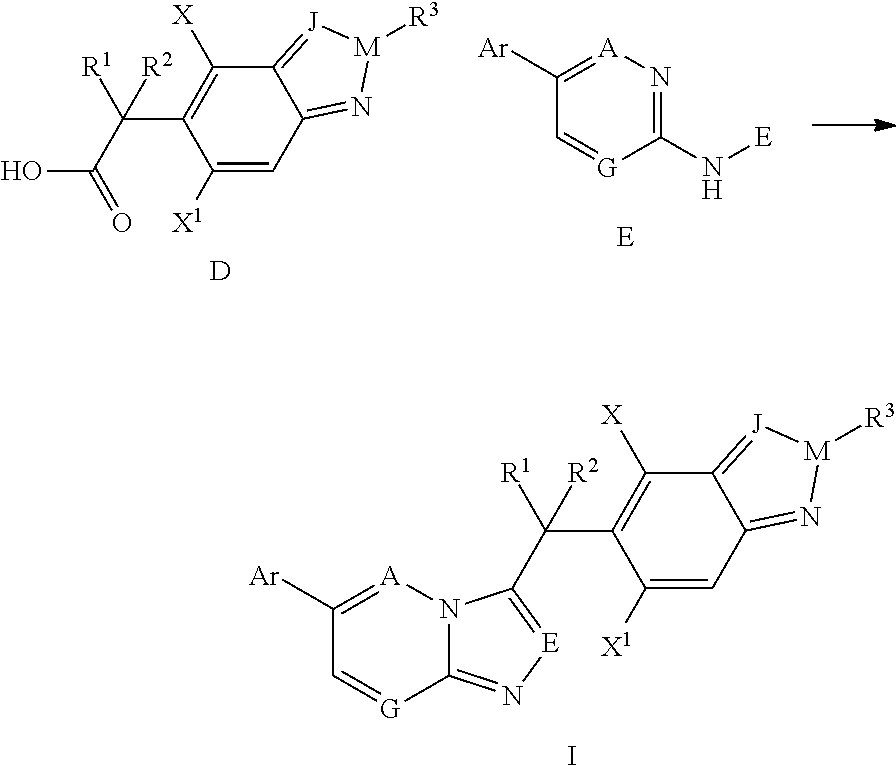Highly selective c-met inhibitors as anticancer agents
a c-met inhibitor, high-selector technology, applied in the direction of heterocyclic compound active ingredients, drug compositions, biocides, etc., can solve the problems of high invasiveness and metastasis of cell lines with uncontrolled c-met activity cell lines
- Summary
- Abstract
- Description
- Claims
- Application Information
AI Technical Summary
Benefits of technology
Problems solved by technology
Method used
Image
Examples
examples 1-17
are prepared by using the above method from intermediate C2 (Table 1).
TABLE 1Examples 1-17Molecular IonExampleIntermediateStructure[M + 1]+1B1469.12B4484.23B5484.24B6498.25B7496.26B11488.17B12496.28B14452.19B16409.110B17413.111B18429.112B19443.113B20443.1 (M + Na)14B23427.215B25443.216B26471.217B27492.1
example 44
6-(1-Cyclopropyl-1H-pyrazol-4-yl)-3-(difluoro(6-fluoro-2-methyl-(2H-indazol-5-yl)methyl-[1,2,4]triazolo[4,3-b]pyridazine
[0169]
[0170]To a 100 mL round bottom flask is added 1-methoxy-2-propanol (15 mL), methyl sulfonic acid (0.898 g, 9.4 mmol), 2,2-difluoro-2-(6-fluoro-2-methyl-2H-indazol-5-yl)acetohydrazide (2.01 g, 7.8 mmol), and 3-chloro-6-(1-cyclopropyl-1H-pyrazol-4-yl) pyridazine (1.81 g, 8.2 mmol). The reaction mixture is stirred at 90° C. for 16 hr. After removal of solvent, the residue is purified on a silica gel flash chromatography with methanol / dichloromethane (1:20) to yield a light yellow solid (1.32 g, 40% yield). (MS: [M+1] 425)
[0171]Examples 18-52 are prepared from intermediates C1, C3-C5 by using the above methods (Table 2).
TABLE 2Examples 18-52Molecular IonExampleIntermediateStructure[M + 1]+18B1470.119B2470.220B3498.221B4484.122B5484.123B6498.224B7496.225B8510.226B9526.227B10539.328B11488.229B12496.230B13453.231B14453.232B16410.233B17414.234B18430.235B20421.236B214...
example 1
Biological Activity Example 1
[0172][Method] Use Lance@Ultra Ulight™-TK test kits from PerKinElmer to evaluate the inhibition of c-Met kinase by the compounds
[0173][Instrument] ENVISION plate reader of PerKinElmer
[0174][Materials] Optiplate-384 well plate (PerKinElmer), kinase buffer (50 mM Hepes pH7.5, 25 mM NaCl, 2 mM DTT, 0.01% Tween 20, 5 mM Mg2+, 0.5 mM Mn2+), c-Met kinase (1038-1346AA, prepared in-house), c-Met substrate (PerKinElmer, #TRF0127-M), Lance@Eu-W 1024-anti-phosphotyrosine (PT66), (PerKinElmer, #AD0068), ATP (Invitrogen), DMSO (Sigma, #34869), water (Millipore, model Milli-Q).
[0175][Procedure] A mixture of c-Met kinase (final concentration 12.5 nM) and test compound (final DMSO is 0.5%) is pre-incubated at 30° C. for 20 min. Then ATP (final concentration 2.5 uM) and kinase substrate (final concentration 50 nM) are added. The resulting mixture is kept at 30° C. for 1 hr, followed by addition of the c-Met antibody. After 1 hr, the plate is re...
PUM
| Property | Measurement | Unit |
|---|---|---|
| temperature | aaaaa | aaaaa |
| temperature | aaaaa | aaaaa |
| temperature | aaaaa | aaaaa |
Abstract
Description
Claims
Application Information
 Login to View More
Login to View More - R&D
- Intellectual Property
- Life Sciences
- Materials
- Tech Scout
- Unparalleled Data Quality
- Higher Quality Content
- 60% Fewer Hallucinations
Browse by: Latest US Patents, China's latest patents, Technical Efficacy Thesaurus, Application Domain, Technology Topic, Popular Technical Reports.
© 2025 PatSnap. All rights reserved.Legal|Privacy policy|Modern Slavery Act Transparency Statement|Sitemap|About US| Contact US: help@patsnap.com



